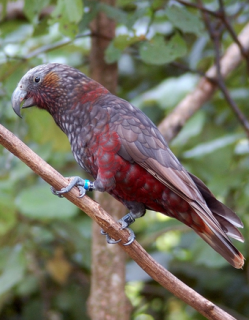Kākā |
|
|
Also known as: New Zealand Kākā
Photos
View in GalleryDid You Know?
The kaka has a fringed tongue, which helps it to feed on nectar. The only other parrots with this type of adaptation are the lories and lorikeets.Programs & Projects
WPT has worked with numerous partners to help save this species. Learn moreAcademic Research
Related publications: Nestor meridionalisSpecies Profile
Genus: Nestor | Species: meridionalis
Size:
45cm (17.5 in)
Weight:
900g (31.5 oz)
Subspecies including nominate:
two: N.m. meridionalis, N.m. septentrionalis
Colour Adult:
N.m. meridionalis: Male-forehead to back of neck grey/white; neck and abdomen brown/red; dark red on hindneck, with feathers margined yellow/brown; olive/brown breast; ear coverts yellow/orange; brown back and wings, mantle some feathers margined red; rump to tail coverts red, tipped dark brown; underwing coverts and bars on underwing red; tail brown with lighter tips. Bill brown/grey; eye dark brown. Female-bill shorter than male, less decurved upper mandible.
N.m. septentrionalis: Both adults generally duller in colour; back and wings darker olive/brown, feathers margined darker; breast darker brown, hindneck duller red; forehead to back of head pale grey.
Colour Juvenile:
N.m. meridionalis: As in adult but base of lower mandible yellow.
N.m. septentrionalis: As in adult.
Call:
Calls in flight harsh and grating, also ringing. Also variety of yodelling notes.
Listen NowVideo Links:
Video 1 | Video 2 | Video 3More Information:
Avibase
New Zealand Birds Online
Content Sources:
CITES
BirdLife International
Cornell Lab of Ornithology/Birds of the World
Parrots: A Guide to Parrots of the World, Juniper and Parr, 1998
Parrots: Status Survey and Conservation Plan 2000-2004, Snyder, McGowan, Gilardi and Grajal, 2000.
ML Media Collection Catalogue 77525, Kaka Nestor meridionalis, Robbins, Mark, New Zealand, Dec. 19 1990, Cornell Lab of Ornithology. Site
Parrots of the World, Forshaw and Cooper, 1977. 2010 edition
Vanished and Vanishing Parrots, Forshaw and Knight, 2017.
Parrots of the World, Forshaw and Knight, 2006.
Parrots in Aviculture, Low, 1992.
Lexicon of Parrots, Thomas Arndt.
Parrots: Their Care and Breeding, Low, 1986.
Photos
View in GalleryDid You Know?
The kaka has a fringed tongue, which helps it to feed on nectar. The only other parrots with this type of adaptation are the lories and lorikeets.Programs & Projects
WPT has worked with numerous partners to help save this species. Learn moreAcademic Research
Related publications: Nestor meridionalisSpecies Care
Captive Status:
Rare
Longevity:
Not recorded.
Housing:
Enclosure at least 5m (16.4 ft) square.
Diet:
Seeds, fruits, vegetables, brown bread soaked in nectar, insects such as giant mealworms and larvae.
Enrichment:
Bathing, bird safe chewables, such as wood (fir, pine, elder, willow), heat sterilized pine cones, branches, vegetable tanned leather. Bird-safe rope swings. Puzzle toys where they reach in for food items.
Nest Box Size:
Not recorded.
Clutch Size:
3 to 4
Incubation Time:
20-23 days
Fledging Age:
9-10 weeks
Hatch Weight:
Not recorded.
Peak Weight:
Not recorded.
Weaning Weight:
Not recorded.
Photos
View in GalleryDid You Know?
The kaka has a fringed tongue, which helps it to feed on nectar. The only other parrots with this type of adaptation are the lories and lorikeets.Programs & Projects
WPT has worked with numerous partners to help save this species. Learn moreAcademic Research
Related publications: Nestor meridionalisSpecies Wild Status
World Population:
3750-15,000
IUCN Red List Status:
Vulnerable
CITES Listing:
Appendix II
Threat Summary:
Affected by forest clearing and predation by species including stoats, black rats and the brush-tailed possum. Introduced wasps and possums compete for honeydew (which appears to have a disastrous impact on breeding performance). Reasonably common only on offshore islands such as Little Barrier, Codfish and Kapiti.
Range:
N.m. meridionalis: South and Stewart Islands and larger offshore islands of New Zealand.
N.m. septentrionalis: North Island and some offshore islands.
Habitat:
Restricted to unbroken areas of low to mid altitude Nothofagus and Podocarpus forest. Occasional visitor to gardens and orchards in winter. Between 450-1000m (1476-3280 ft).
Wild Diet:
Forages for fruits, including Podocarpus ferrugineus, Beilschmiedia tarairi, berries, Agathis australis seeds, flowers, buds, nectar and invertebrates. Sap of Pseudopanax colensoi, Griselinia littoralis, Nothofagus solandri, Metrosideros umbellata, Dacrydium cupressinum, puriri (Vitex lucens) and kohekohe (Dysoxylum spectabile). Also feeds at conifers as Cupressus macrocarpa, Chamaecyparis lawsoniana and Cryptomeria japonica. Also consumes honeydew from the scale insect Ultracoelostoma assimile and larvae of the longhorn beetle Ochrocydus huttoni. Recorded feeding in kiwifruit orchard and on flax flowers.
Ecology and Behaviour:
Kaka go after grubs by whittling at wood trunks. These birds are powerful and acrobatic fliers, active from half an hour before dawn to after dusk, and may perform noisy pre-roosting flights. They are silent and hard to detect while foraging in trees. In the north they travel freely between the islands.
Clutch and Egg Size:
3 to 4 elliptical eggs, 41.0 x 31.0mm (1.6 x 1.2 in).
Breeding Season:
September-March; nest is in large cavity in tree trunk.
Related Links:
Wikipedia
Research: The role of introduced predators...in the decline of Kaka populations in New Zealand
Research: The reintroduction of Kaka to Mount Bruce Reserve, Wairarapa, New Zealand
Photos
View in GalleryDid You Know?
The kaka has a fringed tongue, which helps it to feed on nectar. The only other parrots with this type of adaptation are the lories and lorikeets.Programs & Projects
WPT has worked with numerous partners to help save this species. Learn moreAcademic Research
Related publications: Nestor meridionalisMembers Only Resources
Please log-in now to find more research, resources and tools.
Not a Member?
Find more great information:
Gain exclusive access to 600+ pages of additional research, seminars and podcasts, specialists to ask your toughest questions, and dozens of other fun resources - when you become a WPT member.
Join Today >>

































